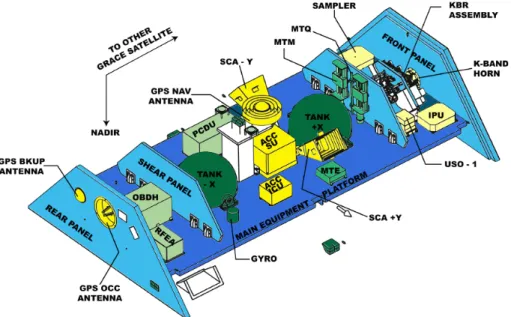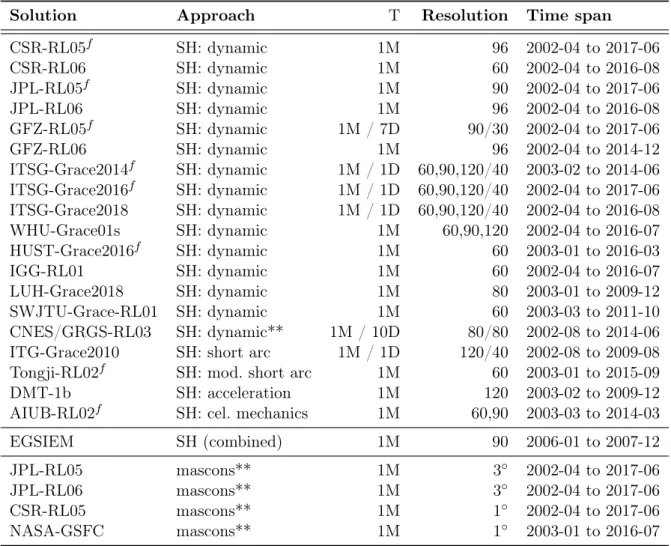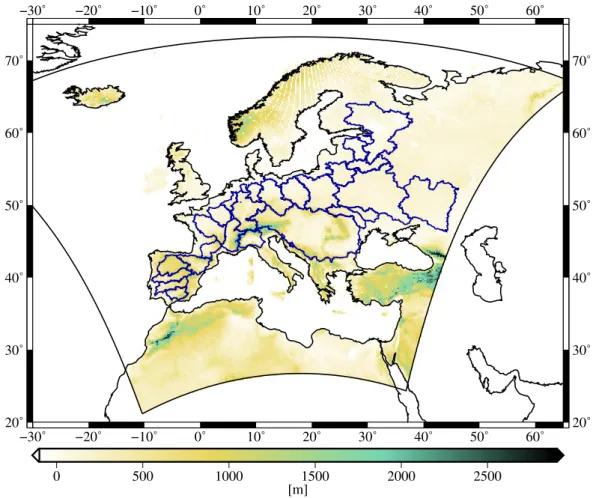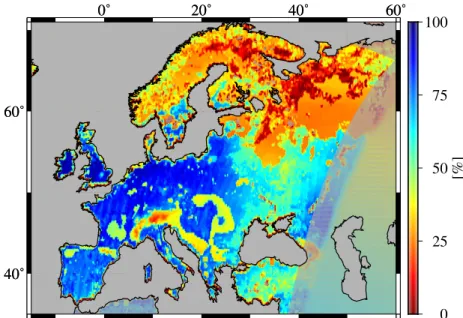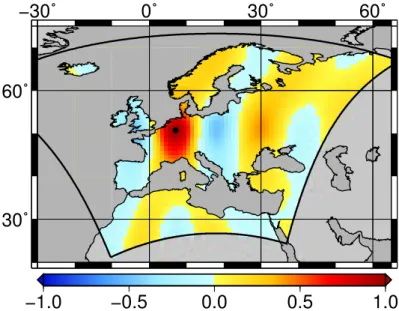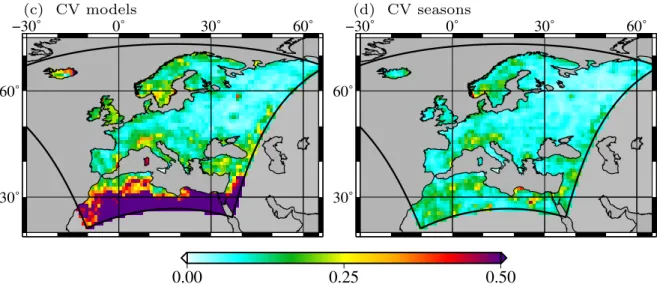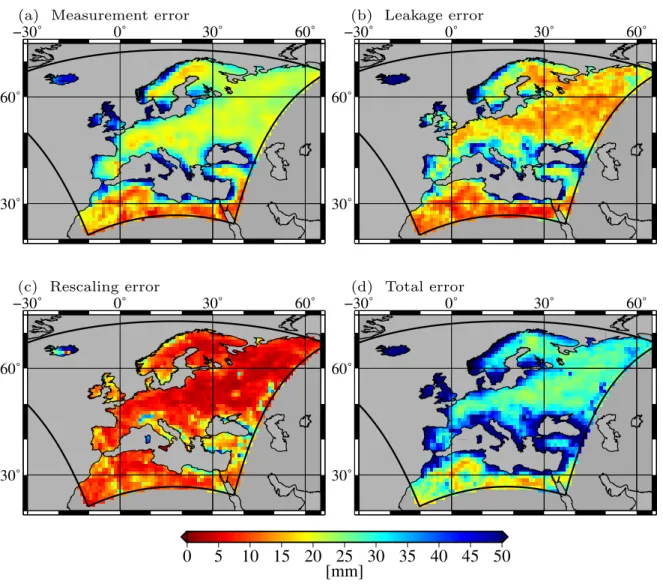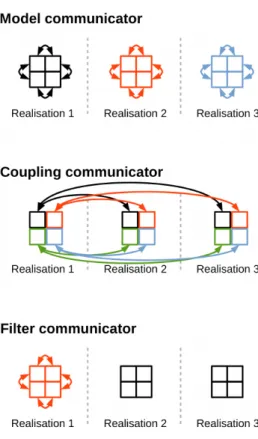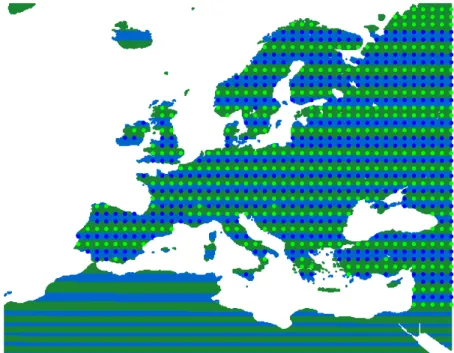Veröffentlichungen der DGK
Ausschuss Geodäsie der Bayerischen Akademie der Wissenschaften
Reihe C Dissertationen Heft Nr. 860
Anne Springer
A water storage reanalysis over the European continent:
assimilation of GRACE data into a high-resolution hydrological model and validation
München 2020
Verlag der Bayerischen Akademie der Wissenschaften
ISSN 0065-5325 ISBN 978-3-7696-5272-7
Diese Arbeit ist gleichzeitig veröffentlicht in:
Schriftenreihe des Instituts für Geodäsie und Geoinformation der Rheinischen Friedrich -Wilhelms
Universität Bonn, ISSN 2699-6685, Nr. 69, Bonn 2020
Veröffentlichungen der DGK
Ausschuss Geodäsie der Bayerischen Akademie der Wissenschaften
Reihe C Dissertationen Heft Nr. 860
A water storage reanalysis over the European continent:
assimilation of GRACE data into a high-resolution hydrological model and validation
Dissertation
zur Erlangung des akademischen Grades Doktorin der Ingenieurwissenschaften
(Dr.-Ing.) der
Landwirtschaftlichen Fakultät der
Rheinischen Friedrich–Wilhelms–Universität Bonn
vorgelegt von
Anne Springer
aus Siegburg
Verlag der Bayerischen Akademie der Wissenschaften
ISSN 0065-5325 ISBN 978-3-7696-5272-7
Diese Arbeit ist gleichzeitig veröffentlicht in:
Schriftenreihe des Instituts für Geodäsie und Geoinformation der Rheinischen Friedrich-Wilhelms Universität Bonn,
ISSN 2699-6685, Nr. 69, Bonn 2020
Adresse der DGK:
Ausschuss Geodäsie der Bayerischen Akademie der Wissenschaften (DGK)
Alfons-Goppel-Straße 11 ● D – 80539 MünchenTelefon +49 – 331 – 288 1685 ● Telefax +49 – 331 – 288 1759 E-Mail post@dgk.badw.de ● http://www.dgk.badw.de
Prüfungskommission:
Referent: Prof. Dr. Jürgen Kusche Korreferent: Dr. Laurent Longuevergne Korreferent: Prof. Dr. Stefan Kollet Tag der mündlichen Prüfung: 08.03.2019
© 2020 Bayerische Akademie der Wissenschaften, München
Alle Rechte vorbehalten. Ohne Genehmigung der Herausgeber ist es auch nicht gestattet,
die Veröffentlichung oder Teile daraus auf photomechanischem Wege (Photokopie, Mikrokopie) zu vervielfältigen.
ISSN 0065-5325 ISBN 978-3-7696-5272-7
data into a high-resolution hydrological model and validation Summary
Continental water storage and redistribution within the Earth’s system are key variables of the terrestrial water cycle. Changes in water storage and fluxes may affect resources for drinking water and irrigation, lead to drought or flood conditions, or cause severe changes of ecosys- tems e.g., through salinification. Hydrological models, which map water storages and fluxes, are being continuously improved and deepen our understanding of geophysical processes re- lated to the water cycle. However, models are built on a simplified representation of reality, which leads to limited predicting skills of the simulation results. Assimilating remotely sensed total water storage variability from the Gravity Recovery and Climate Experiment (GRACE) mission has become a valuable tool for reducing uncertainties of hydrological model simula- tions. Simultaneously, coarse GRACE observations are disaggregated spatially and temporally through data assimilation.
In this thesis, GRACE data are assimilated into the Community Land Model version 3.5 (CLM3.5) yielding a unique daily 12.5 km reanalysis of total water storage evolution over Eu- rope (2003 to 2010). Independent observations are evaluated to identify model deficits and to validate the performance of data assimilation. For the first time, the effect of data assimilation on modeled total water storage is also shown on the level of GRACE K-band observations.
Optimal strategies for assimilating GRACE data into a high-resolution hydrological model are investigated through synthetic experiments. These experiments address the choice of the assimilation algorithm, localization, inflation of the ensemble of model states, ensemble size, error model of the observations, and spatial resolution of the observation grid.
As the assimilation of GRACE data into CLM3.5 is realized within the Terrestrial Systems Modeling Platform (TerrSysMP), future assimilation experiments can be extended for the groundwater and atmosphere components included in TerrSysMP.
Eine Reanalyse des europäischen Wasserspeichers: Assimilierung von GRACE Daten in ein hochaufgelöstes hydrologisches Modell und Validierung
Zusammenfassung
Änderungen im kontinentalen Wasserspeicher und im Transport von Wasser durch das Erdsys- tem sind wichtige Einflussgrößen für die Verfügbarkeit von Frischwasserresourcen, die Entste- hung von Dürren und Überschwemmungen, sowie für die Erhaltung von Ökosystemen, welche z.B. durch Versalzung gefährdet werden. Hydrologische Modelle, die die Speicherung und den Transport von Wassermassen abbilden, werden stetig verbessert und helfen unser Verständ- nis von hydrologischen Prozessen zu vertiefen. Allerdings ermöglichen hydrologische Modelle nur eine vereinfachte Abbildung der Realität, sodass die Aussagekraft der Simulationsergeb- nisse beschränkt ist. Die Assimilierung von Wasserspeicheränderungen, gemessen von den GRACE (Gravity Recovery and Climate Experiment) Satelliten, kann hydrologische Simu- lationen verbessern und erlaubt gleichzeitig eine räumliche und zeitliche Differenzierung der grobaufgelösten GRACE Beobachtungen.
In dieser Doktorarbeit werden GRACE Daten in das Land-Oberflächen-Modell CLM3.5 (Com- munity Land Model Version 3.5) assimiliert, um eine neuartige Reanalyse täglicher Wasser- speicheränderungen (2003 bis 2010) für Europa mit 12.5 km Auflösung zu generieren. Durch unabhängige Beobachtungen werden Defizite des Modells identifiziert und das Ergebnis der Datenassimilierung beurteilt. Zum ersten Mal wird auch die Auswirkung der Assimilierung di- rekt auf Basis der GRACE K-Band Beobachtungen untersucht. Mit Hilfe synthetischer Experi- mente wird die beste Strategie zur Assimilierung von GRACE Daten in ein hochaufgelöstes hy- drologisches Modell ermittelt. Dabei wird der Einfluss unterschiedlicher Assimilierungsstrate- gien untersucht, unter anderem die Wahl des Assimilierungsalgorithmus, die Lokalisierung des Einflussbereichs von Beobachtungen, die Erhöhung der Spannweite der Ensemblemitglieder des Modells, die Ensemblegröße, das Fehlermodell der Beobachtung und die räumliche Auflö- sung des Beobachtungsgitters.
Da die Assimilierung von GRACE in das CLM3.5 Modell unter Verwendung von TerrSysMP
(Terrestrial Systems Modeling Platform) geschieht, können die Assimilierungsexperimente in
Zukunft auf die zusätzliche Verwendung des in TerrSysMP enthaltenen Grundwasser- und des
Atmosphärenmodells erweitert werden.
First of all, I would like to thank Jürgen Kusche for supervising my PhD thesis. He guided me through the whole process and gave me the possibility to work on several different aspects of physical and satellite geodesy and to gain insights also into neighboring disciplines. I always appreciated our talks and I have learned a lot from your explanations and from your always further reaching questions. For me, it was also essential that I could develop my own ideas and that I had the possibility to discuss them at several international conferences.
I would like to thank Annette Eicker for our productive collaborations and for sharing her knowledge with me. I always enjoyed a lot to solve problems jointly with you.
Furthermore, I would like to thank Jessica Keune for providing the initial set-up of CLM3.5 and for answering a number of hydrology-related questions with a lot of patience. I am also grateful to Wolfgang Kurtz who provided the interfaces routines between PDAF and CLM3.5 to me. I really enjoyed our talks and your interest in my work. My understanding of inter- relations between geodesy and hydrology were also furthered by discussions with Bibi Naz, Stefan Kollet, Laurent Longuevergne, Thomas Poméon, and Bernd Diekkrüger. Thank you for opening new and interesting perspectives to me. In particular, I would like to thank Laurent Longuevergne for helping me to gain experiences with a first very simple hydrological model.
A meeting with Lars Nerger, the developer of the parallel data assimilation framework PDAF, was particular important for me to understand that the results from data assimilation are not always straightforward. This was very encouraging for the next steps of my work.
I acknowledge a DAAD grant for spending three months in Rennes (France) with Laurent Longuevergne. This was a very fruitful time for me and I really enjoyed the working environ- ment. I would also like to acknowledge funding by the Centre for High-Performance Scientific Computing in Terrestrial Systems (HPSC-TerrSys) and funding by the COAST (Studying changes of sea leveland water storage for coastal regions in West-Africa using satellite and terrestrial datasets) project, supported by the Deutsche Forschungsgemeinschaft under Grant No. KU1207/20-1.
Proof reading made this thesis a great deal better and, therefore, I would like to thank my colleagues Bernd Uebbing, Christina Lück, Alexander Harker, Kerstin Schulze, Joël Köhler, Helena Gerdener, Kristin Vielberg, Sophie Stolzenberger, and Anno Löcher for reading parts of my thesis and for making valuable suggestions. Many thanks go to Katrin Almon who spend a lot of time reading the whole thesis. I am really grateful for this. Whenever my computer or our compute cluster reacted not as expected I got help from Judith Schall, Roelof Rietbroek, Jan Martin Brockmann, Christian Neyer, Michael Plümer, and Bernd Uebbing. Thank you for spending time with these issues.
Finally, I would like to thank all my past and present colleagues of APMG and TG for a fruitful and friendly working environment, which makes it easy to work efficiently. I am par- ticularly grateful for my wonderful office mates Judith and Helena. I really enjoyed our talks.
A completely different contribution to this work was made by my parents, Carola and Bern-
hard Springer, through baby-sitting, cooking, and baking. Your support was indispensable for
finishing this thesis. Thank you for your efforts! Andreas Ernst provided me with continuous
support, interest in my work, and trust in my abilities during the process that lead to this
thesis. I thank you with all my heart. Finally, my dear son Fabian (unwittingly) helped me
to finish this thesis by distracting me from work (but not too much) and by opening to me a
completely different view on the world.
Contents
1 Introduction 1
1.1 Motivation . . . . 1
1.2 Terrestrial Water Cycle and Space Gravimetry . . . . 2
1.3 Scientific Context and Objectives of the Thesis . . . . 3
1.4 Organization of the Thesis . . . . 4
2 Gravity Recovery and Climate Experiment GRACE 5 2.1 GRACE Satellite Mission . . . . 5
2.2 GRACE Data Processing . . . . 8
2.3 GRACE Analysis Centers and GRACE Solutions . . . . 10
3 Related Work 13 3.1 Validation of Hydrological Models Using GRACE Data . . . . 13
3.1.1 Total Water Storage Time Series . . . . 14
3.1.2 K-Band Range Rate Residuals . . . . 15
3.2 Assimilation of GRACE Data into Hydrological Models . . . . 16
4 Modeling Terrestrial Water Storage 23 4.1 Community Land Model version 3.5 . . . . 23
4.1.1 Model Structure . . . . 24
4.1.2 Water Balance . . . . 25
4.1.3 Model Setup . . . . 28
4.2 Global Hydrological Models . . . . 31
4.2.1 WGHM . . . . 31
4.2.2 LSDM . . . . 31
4.2.3 GLDAS Land Surface Models . . . . 31
4.3 Validation Data Sets . . . . 32
4.3.1 Soil Moisture . . . . 32
4.3.2 Discharge . . . . 33
4.3.3 Evapotranspiration . . . . 35
5 Processing of GRACE Data 37 5.1 Computing Gridded Total Water Storage Anomalies from GRACE Level-2 Data 37
5.1.1 From Gravity Potential to Total Water Storage Anomalies . . . . 38
5.1.2 Coefficients of Lower Degree . . . . 40
5.1.3 Removing Correlated Errors . . . . 41
5.1.4 Glacial Isostatic Adjustment . . . . 46
5.1.5 Error Propagation . . . . 47
5.2 Computing K-Band Residuals from GRACE Level 1B Data . . . . 53
5.2.1 Preparation of GRACE Level 1B Data . . . . 53
5.2.2 Computation of K-band Residuals . . . . 54
5.2.3 Evaluation of K-band Residuals . . . . 54
6 Concepts of Sequential Data Assimilation 57 6.1 Ensemble Kalman Filter Approaches . . . . 58
6.1.1 The Extended Kalman Filter . . . . 59
6.1.2 The Ensemble Kalman Filter . . . . 60
6.1.3 The Ensemble Transform Kalman Filter . . . . 61
6.1.4 The Singular Evolutive Interpolated Kalman Filter . . . . 62
6.1.5 The Error Subspace Transform Kalman Filter . . . . 62
6.1.6 Smoother Extensions . . . . 63
6.2 Tuning of the Filter Algorithms . . . . 63
6.2.1 Localization . . . . 63
6.2.2 Covariance Inflation . . . . 65
7 Implementing the Assimilation of GRACE Data into CLM3.5 67 7.1 The Assimilation Framework TerrSysMP-PDAF . . . . 69
7.2 Interface for Assimilating Total Water Storage Anomalies . . . . 72
7.2.1 State Vector . . . . 72
7.2.2 Observation Files . . . . 72
7.2.3 Observation Operator . . . . 73
7.2.4 Model Update . . . . 76
7.3 Generating an Ensemble of Model Runs with CLM3.5 . . . . 78
7.3.1 Initial Conditions . . . . 79
7.3.2 Atmospheric Forcings . . . . 79
7.3.3 Soil Texture . . . . 81
8.1 Validation Metrics . . . . 86
8.2 Assimilation of Synthetic Total Water Storage Observations . . . . 88
8.2.1 Twin Experiments . . . . 88
8.2.2 Influence of Data Assimilation on the TWS Compartments . . . . 91
8.2.3 Influence of the Ensemble Size . . . 101
8.2.4 Influence of Assimilation Algorithm and Observation Error Model . . . 104
8.2.5 Influence of Localization Radius and Inflation Factor . . . 109
8.2.6 Influence of the Observation Grid . . . 112
8.2.7 Influence of Data Assimilation on Sub-Monthly TWS Variability . . . 115
8.2.8 Influence of Biases in Precipitation Forcings . . . 116
8.2.9 Influence of Phase Shifts between Model and Observations . . . 117
8.2.10 Key Messages of Synthetic Assimilation Experiments . . . 118
8.3 Assimilation of GRACE-Derived Total Water Storage Observations . . . 120
8.3.1 Set-up of Assimilation Experiments with Real GRACE Data . . . 120
8.3.2 Comparison of GRACE Data and Output from the Assimilated Model 121 8.3.3 Analysis of Assimilation Increments . . . 124
8.3.4 Validation against Soil-Moisture Observations . . . 125
8.3.5 Validation against Discharge Gauges . . . 132
8.3.6 Validation against Evapotranspiration Observations . . . 134
8.3.7 Examples for Spatial and Temporal Downscaling of GRACE Observations137 8.3.8 Key Messages of GRACE Assimilation Experiments . . . 138
9 Validation of Offline and Assimilated Hydrological Models Using GRACE In-Orbit Residuals 141 9.1 In-Orbit Validation of Global Hydrological Models . . . 144
9.1.1 Time Series of Residuals . . . 144
9.1.2 Spatial Residual Analysis . . . 144
9.1.3 Regional Time Series of Residuals . . . 146
9.2 In-Orbit Validation of Short-Term Hydrological Variability . . . 149
9.3 In-Orbit Validation of Hydrological Signals from Reservoirs . . . 151
9.4 In-Orbit Validation of Data Assimilation Results . . . 153
9.5 Key Messages of the Analysis of KBRR and KBRA Residuals . . . 155
10 Conclusions and Outlook 157 10.1 Summary . . . 157
10.2 Conclusions . . . 158
10.3 Outlook . . . 160
Acronyms 165
List of Figures 175
List of Tables 177
Bibliography 200
Introduction
1.1 Motivation
Terrestrial water storage is a key variable of the global water cycle. The total water storage (TWS) on the continents includes all water components on and underneath the Earth’s sur- face, i.e. groundwater, soil moisture, surface waters (wetlands, rivers, lakes), snow water, and canopy water. Changes in TWS directly affect freshwater availability (Döll et al., 2016; Solan- der et al., 2017; Rodell et al., 2018), and can be related to natural disasters such as droughts and floods (Leblanc et al., 2009; Chew and Small, 2014; Sun et al., 2017). In addition, TWS changes are an important indicator for climate change (Green et al., 2011; Teutschbein et al., 2011; Yang et al., 2015; Kusche et al., 2016). Given the strong interconnection between human life and the terrestrial water cycle, millions of people are affected by natural disasters that can be expressed through TWS change. Well-documented examples are the California drought (Nelson and Burchfield, 2017), and the increasing intensity and duration of monsoon floods in South Eastern Asia (Dewan, 2015).
Changes in TWS and its components are associated with changes in hydrological fluxes, such as infiltration rates, runoff, groundwater recharge, and evapotranspiration. Indirectly, changes in TWS components also affect the atmospheric part of the water cycle and the Earth’s energy cycle. Soil moisture feedbacks on the atmosphere change variables such as air temperature and wind speed. Snow cover affects surface albedo and, thereby, induces changes in atmospheric circulation. Due to its memory effect, groundwater has a huge impact on long-term climate variability. Groundwater recharges soil moisture and, thus influences near-surface processes such as land-use change. Clearly, TWS is linked to a number of variables that were defined as Essential Climate Variables (ECV) by the Global Observing System for Climate (GCOS) under the auspices of United Nations organizations (Bojinski et al., 2014).
Accurate knowledge of TWS and TWS changes is indispensable for sustainable land and water management. Projections of TWS evolution are a basis for developing strategies that guarantee food and water supply, protect human health, preserve ecosystems, control energy generation and prevent migration streams. Finally, monitoring TWS directly targets the United Nation’s sustainable development goal 6, i.e. “ensure availability and sustainable management of water and sanitation for all”
1.
Despite the importance of TWS, its monitoring is challenging. Hydrological models, which map the terrestrial water cycle, are only a simplified representation of reality and suffer from
1
